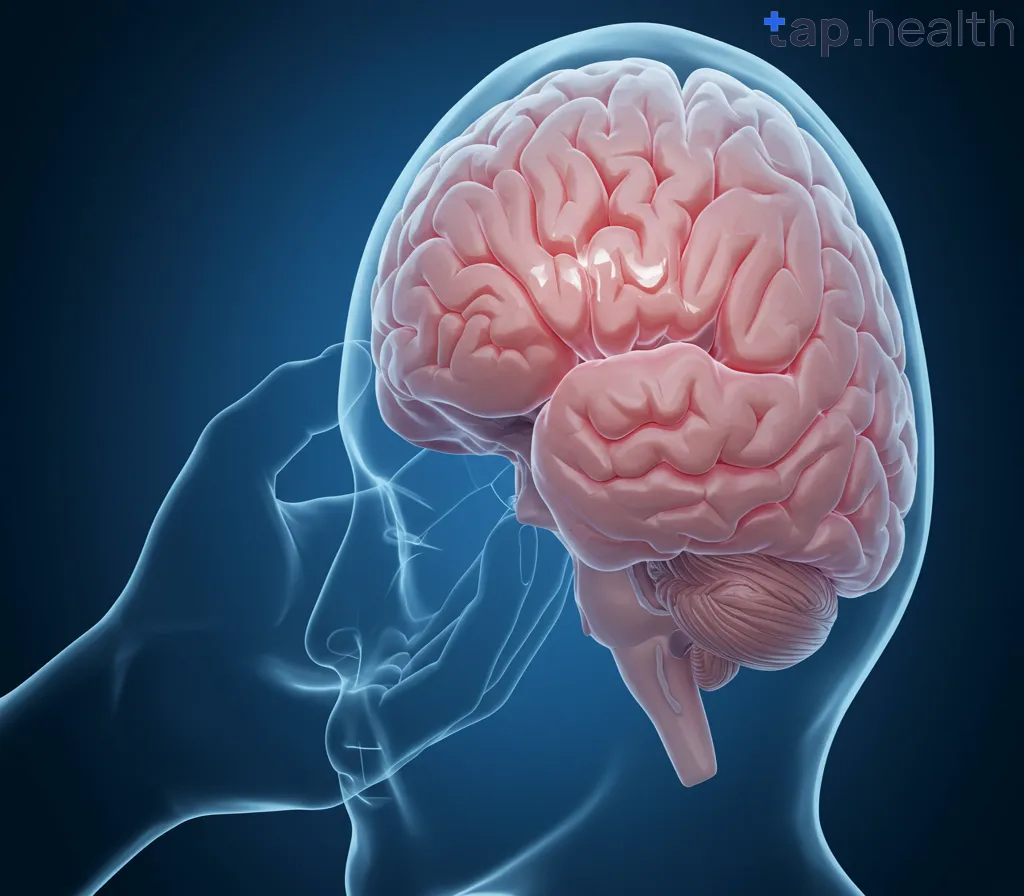A blood clot in the brain, also known as a brain thrombus or ischemic stroke, occurs when a clot blocks the blood flow to certain parts of the brain. This blockage can lead to serious and life-threatening consequences. The symptoms of a brain clot vary depending on the location of the clot and how quickly the blood flow is blocked.
Understanding the symptoms of a blood clot in the brain is crucial, as timely treatment can prevent severe brain damage or even death. In this article, we’ll explore the symptoms of a blood clot in the brain, the different types of strokes, and what to do if you or someone else shows signs of a brain clot. We’ll also cover treatment options and the importance of early diagnosis.
What Is a Blood Clot in the Brain?
Before diving into the symptoms, it’s essential to understand what a blood clot in the brain is and how it forms.
A blood clot in the brain occurs when a clot forms in one of the brain’s blood vessels, obstructing the flow of oxygenated blood to the brain tissue. There are two primary types of strokes caused by blood clots:
1. Ischemic Stroke
- An ischemic stroke occurs when a clot blocks one of the arteries supplying blood to the brain.
- This is the most common type of stroke and accounts for around 87% of all stroke cases.
2. Transient Ischemic Attack (TIA)
- Also known as a mini-stroke, a TIA is a temporary blockage of blood flow in the brain. While it does not cause permanent damage, it’s a warning sign for future strokes.
What Are the Symptoms of a Blood Clot in the Brain?
Recognizing the symptoms of a blood clot in the brain early can save a life. The symptoms of a brain clot can vary, but there are common signs that should never be ignored.
1. Sudden Numbness or Weakness
The most common symptom of a blood clot in the brain is sudden numbness or weakness, often on one side of the body. This can affect the face, arm, or leg. The person may not be able to move or feel one side of their body.
What to Watch For:
- One side of the face may droop when the person tries to smile.
- The person may be unable to raise both arms equally or hold them up for a long period.
2. Confusion or Trouble Speaking
If a blood clot in the brain is affecting the areas responsible for language and comprehension, the person may experience sudden confusion or difficulty speaking. This may include trouble understanding speech or slurring words.
Key Symptoms:
- The person may struggle to form sentences or understand questions.
- They may speak in a confused or garbled manner, making it hard to understand them.
3. Sudden Severe Headache
A sudden, intense headache that is different from previous headaches could be a warning sign of a blood clot in the brain. This headache may occur with nausea or vomiting.
What to Watch For:
- A thunderclap headache, which is a severe and sudden headache that reaches its peak intensity in a few seconds, could indicate a stroke caused by a clot.
4. Vision Problems
If the blood clot affects the areas of the brain responsible for vision, the person may experience sudden vision problems in one or both eyes. They may have difficulty seeing out of one eye, or their vision may become blurry or double.
What to Watch For:
- Sudden loss of vision in one or both eyes.
- Blurred or double vision, especially in one eye.
5. Dizziness, Loss of Balance, or Coordination
A blood clot in the brain can disrupt the balance centers in the brain, causing dizziness, vertigo, and problems with coordination. This can make it hard for the person to walk or maintain their balance.
What to Watch For:
- Feeling dizzy or lightheaded.
- Difficulty standing or walking without losing balance.
- Uncontrolled movements or difficulty coordinating limbs.
6. Trouble Walking
A blood clot can cause a sudden loss of coordination, making it hard for the person to walk. They may find it challenging to walk straight or may stumble frequently.
Key Symptoms:
- Unsteady gait.
- The person may trip over their feet or have difficulty walking in a straight line.
7. Severe Vomiting or Nausea
A blood clot in the brain can lead to increased pressure in the skull, which can cause symptoms like nausea or vomiting. This often occurs in conjunction with other symptoms like headaches and confusion.
What to Watch For:
- Nausea and vomiting that appear suddenly without an obvious cause.
- Feeling lightheaded or dizzy after vomiting.
8. Seizures
In some cases, a blood clot in the brain can lead to seizures. This is more common in individuals who have a large clot affecting a significant portion of the brain.
Key Symptoms:
- Uncontrolled jerking or shaking movements in any part of the body.
- Loss of consciousness or awareness during a seizure.
How to Recognize a Stroke – The FAST Method
The FAST method is a simple way to quickly recognize a stroke, including a blood clot in the brain. It stands for:
1. F – Face Drooping
Ask the person to smile. Does one side of the face droop or feel numb?
2. A – Arm Weakness
Ask the person to raise both arms. Does one arm drift downward or feel weak?
3. S – Speech Difficulty
Ask the person to repeat a simple sentence. Is their speech slurred or strange? Are they unable to speak at all?
4. T – Time to Call Emergency Services
If you notice any of these signs, it’s important to call emergency services immediately. Time is critical in treating a blood clot in the brain, and quicker treatment increases the chances of recovery.
How Is a Blood Clot in the Brain Diagnosed?
If a blood clot in the brain is suspected, a healthcare provider will typically use imaging tests and other diagnostic methods to confirm the diagnosis.
1. CT Scan (Computed Tomography)
A CT scan is often the first imaging test used to detect a blood clot in the brain. It helps doctors identify the location of the clot and any swelling or damage to brain tissue.
2. MRI (Magnetic Resonance Imaging)
An MRI provides a more detailed image of the brain and is particularly useful for identifying brain tissue damage. It can detect smaller clots that might not show up on a CT scan.
3. Angiography
In some cases, angiography may be used to visualize the blood vessels in the brain and identify the location of a clot. This test involves injecting a contrast dye into the blood vessels to make them visible on X-ray images.
4. Blood Tests
Blood tests may also be used to assess the risk of clotting and determine if there are underlying conditions that could have caused the blood clot.
Treatment for a Blood Clot in the Brain
Treating a blood clot in the brain requires immediate medical attention. Treatment options depend on the size, location, and severity of the clot. Common treatments include:
1. Thrombolytic Therapy (Clot-Busting Drugs)
One of the most common treatments for ischemic strokes (caused by blood clots) is thrombolysis. This involves using clot-busting drugs like tPA (tissue plasminogen activator) to dissolve the clot and restore blood flow to the brain. tPA must be administered within 3-4.5 hours of the stroke’s onset for maximum effectiveness.
2. Mechanical Thrombectomy
For larger clots, a procedure called mechanical thrombectomy may be performed. This involves using a catheter to physically remove the clot from the artery, improving blood flow to the brain.
3. Anticoagulants and Antiplatelet Medications
Once the clot is dissolved or removed, medications like anticoagulants (blood thinners) or antiplatelet drugs (like aspirin) are used to prevent future clots from forming.
4. Surgery
In cases where a clot cannot be dissolved with medications, surgery may be needed to remove the clot and relieve pressure on the brain.
When Should You Seek Medical Help?
If you or someone around you experiences any of the symptoms of a blood clot in the brain, seek emergency medical help immediately. Time is crucial in treating brain clots, and the sooner the treatment begins, the better the chances for recovery.
FAQ on What Are the Symptoms of a Blood Clot in the Brain?
1. What are the common symptoms of a blood clot in the brain?
Common symptoms include sudden numbness or weakness on one side of the body, confusion, difficulty speaking, severe headache, dizziness, vision problems, and trouble walking.
2. How is a blood clot in the brain diagnosed?
A blood clot in the brain is diagnosed using CT scans, MRI, and sometimes angiography to visualize the blood vessels and the location of the clot.
3. What should I do if I suspect a blood clot in the brain?
If you suspect a blood clot in the brain, call emergency services immediately. Use the FAST method to check for signs of stroke and get medical help right away.
4. Can a blood clot in the brain be treated?
Yes, blood clots in the brain can be treated with clot-busting drugs, mechanical thrombectomy, and medications like anticoagulants to prevent further clots.
5. How can I reduce my risk of blood clots in the brain?
To reduce the risk, maintain a healthy lifestyle, including a balanced diet, regular exercise, and controlling risk factors like high blood pressure and high cholesterol. Avoid smoking and excessive alcohol consumption.
Conclusion
A blood clot in the brain is a medical emergency that requires immediate attention. Recognizing the symptoms, such as sudden numbness, confusion, and trouble speaking or walking, can help you take quick action. With timely treatment, the chances of recovery from a brain clot are significantly improved. Always seek medical help if you experience any of these symptoms or if you suspect a loved one is suffering from a blood clot in the brain. Early intervention is crucial for minimizing brain damage and maximizing recovery.



